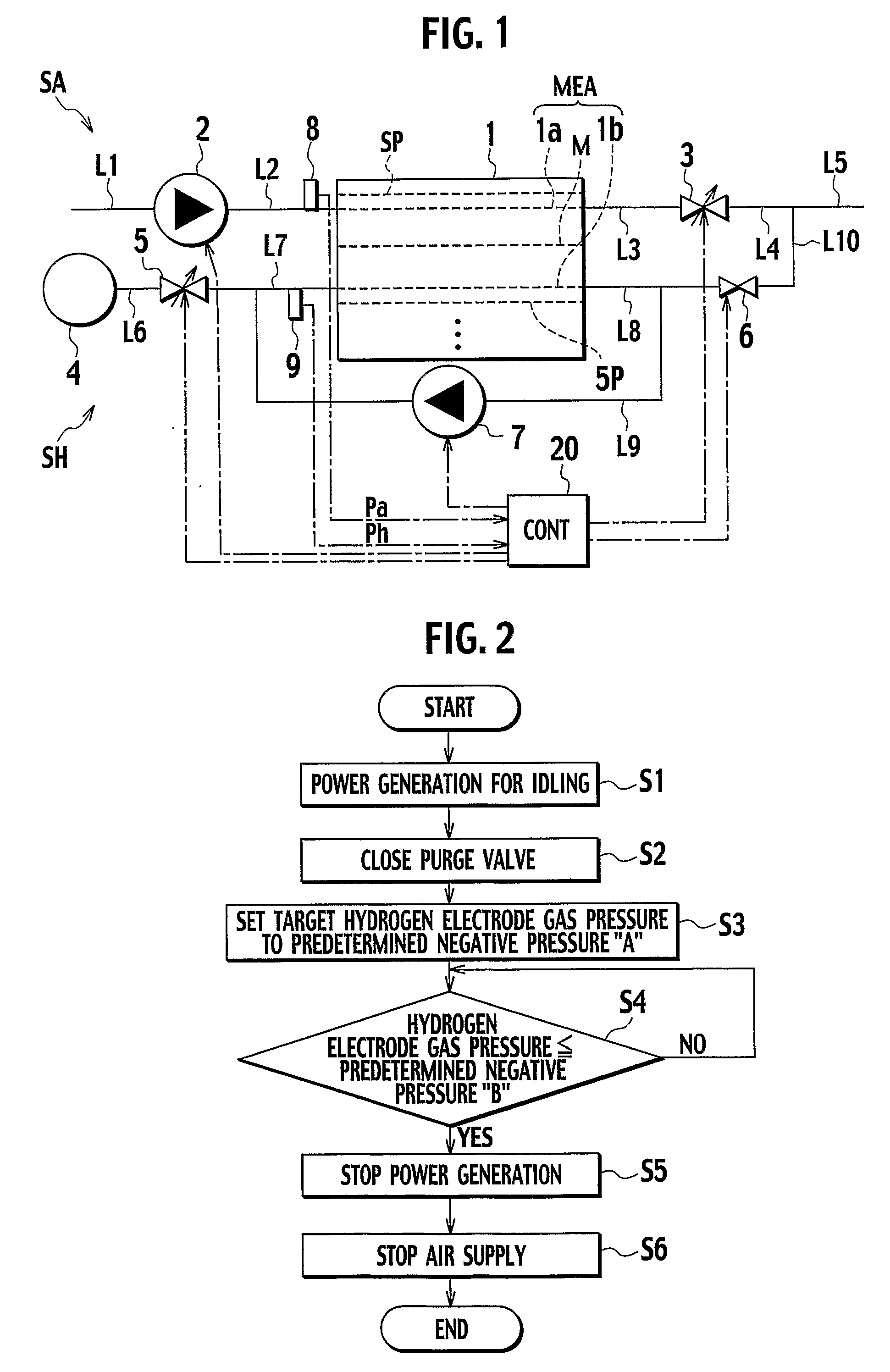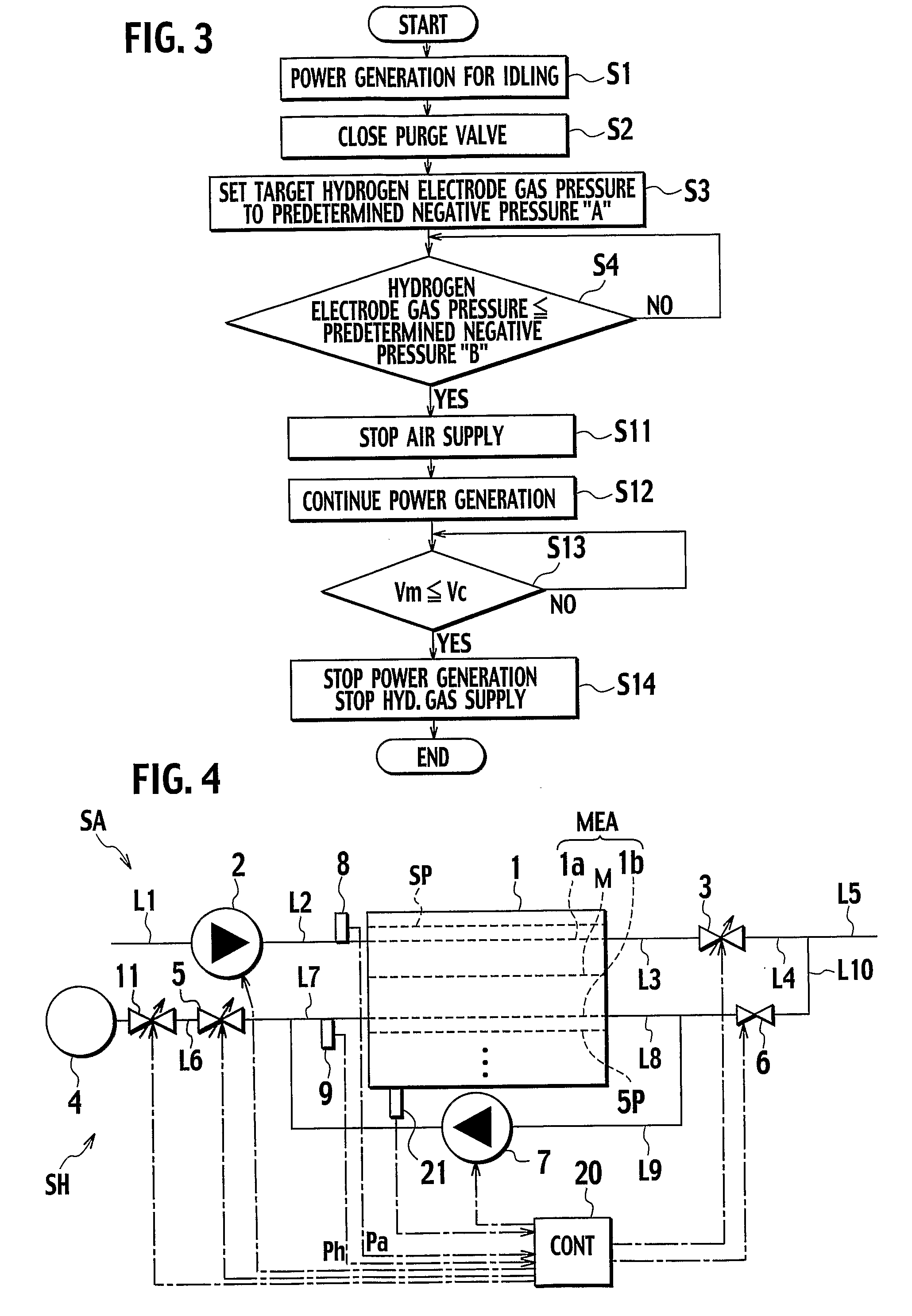Fuel Cell System
a fuel cell and system technology, applied in the direction of fuel cell control, fuel cells, electrical equipment, etc., can solve the problems of difficult detection of sealing defects, difficult to obtain fuel exhaust air, and high concentration of hydrogen gas leakage through the purge valve to the outside of the system, so as to reduce the hydrogen concentration of exhaust gas and reduce the concentration of fuel gas
- Summary
- Abstract
- Description
- Claims
- Application Information
AI Technical Summary
Benefits of technology
Problems solved by technology
Method used
Image
Examples
first embodiment
[0023]The present invention is applied to, for example, a fuel cell system configured as shown in FIG. 1.
[0024]This fuel cell system includes a fuel cell stack 1 in which a plurality of unit cells are stacked on one another. Each of the unit cells (a fuel cell) is configured with a membrane electrode assembly MEA and a pair of separators SP sandwiching the MEA. The membrane electrode assembly MEA includes an air electrode 1a (oxidant electrode), a hydrogen electrode 1b (fuel electrode), and a polymer electrolyte membrane M interposed therebetween. The fuel cell stack 1 generates electric power by an electrochemical reaction between hydrogen gas supplied as a fuel gas to the hydrogen electrodes 1b and air supplied as an oxidant gas to the air electrodes 1a.
[0025]The fuel cell system includes an air system SA and a hydrogen gas system SH. The air is introduced into and discharged from the air electrodes 1a of the fuel cell stack 1 by the air system SA. The hydrogen gas is introduced ...
second embodiment
[0042]Next, a description will be given of a fuel cell system according to a second embodiment. Note that, with respect to the same parts as those of the first embodiment, detailed descriptions are omitted, giving the same reference numerals and characters thereto.
[0043]The fuel cell system according to the second embodiment is characterized in that an operation is added of consuming oxygen of the air electrodes 1a at the time of stopping power generation of the fuel cell stack 1.
[0044]In the power generation stopping process in the second embodiment, as shown in FIG. 3, after it is judged that the gas pressure at the hydrogen electrodes 1b has become the second predetermined negative pressure B or lower in Step S4, the operation of the compressor 2 is stopped in Step S11 in order that the air supply to the fuel cell stack 1 can be stopped. Then in Step S12, the opening of the hydrogen gas pressure regulating valve 5 is adjusted so as to supply hydrogen, which is equivalent in amoun...
third embodiment
[0049]Next, a description will be given of a fuel cell system according to a third embodiment. Note that, with respect to the same parts as those of the abovementioned embodiments, detailed descriptions are omitted, giving the same reference numerals and characters thereto.
[0050]The fuel cell system according to the third embodiment, as shown in FIG. 4, is different from the fuel cell system according to the first embodiment in that a hydrogen gas supply shutoff valve 11 is provided in the supply hydrogen gas passage L6 between the hydrogen tank 4 and the hydrogen gas pressure regulating valve 5, and is controlled by the controller 20.
[0051]In the fuel cell system, in a power generation stopping process, the hydrogen gas supply shutoff valve 11 is set closed, while the hydrogen gas pressure regulating valve 5 is set closed, so as to block hydrogen gas supply to the fuel cell stack 1 from the hydrogen tank 4 in order to bring the gas pressure at the hydrogen electrodes 1b to the firs...
PUM
| Property | Measurement | Unit |
|---|---|---|
| pressure | aaaaa | aaaaa |
| pressure | aaaaa | aaaaa |
| electric power | aaaaa | aaaaa |
Abstract
Description
Claims
Application Information
 Login to View More
Login to View More - R&D
- Intellectual Property
- Life Sciences
- Materials
- Tech Scout
- Unparalleled Data Quality
- Higher Quality Content
- 60% Fewer Hallucinations
Browse by: Latest US Patents, China's latest patents, Technical Efficacy Thesaurus, Application Domain, Technology Topic, Popular Technical Reports.
© 2025 PatSnap. All rights reserved.Legal|Privacy policy|Modern Slavery Act Transparency Statement|Sitemap|About US| Contact US: help@patsnap.com



